FQP9N50 - Аналоги. Основные параметры
Наименование производителя: FQP9N50
Тип транзистора: MOSFET
Полярность: N
Pd ⓘ - Максимальная рассеиваемая мощность: 147
W
|Vds|ⓘ - Предельно допустимое напряжение сток-исток: 500
V
|Vgs|ⓘ - Предельно допустимое напряжение затвор-исток: 30
V
|Id| ⓘ - Максимально
допустимый постоянный ток стока: 9
A
Tj ⓘ - Максимальная температура канала: 150
°C
tr ⓘ -
Время нарастания: 95
ns
Cossⓘ - Выходная емкость: 160
pf
Rds ⓘ - Сопротивление сток-исток открытого транзистора: 0.73
Ohm
Тип корпуса:
TO-220
Аналог (замена) для FQP9N50
FQP9N50 технические параметры
..1. Size:709K fairchild semi
fqp9n50.pdf 

April 2000 TM QFET QFET QFET QFET 500V N-ChanneI MOSFET GeneraI Description Features These N-Channel enhancement mode power field effect 9.0A, 500V, RDS(on) = 0.73 @VGS = 10 V transistors are produced using Fairchild s proprietary, Low gate charge ( typical 28 nC) planar stripe, DMOS technology. Low Crss ( typical 20 pF) This advanced technology has been e
0.1. Size:1341K fairchild semi
fqp9n50c.pdf 
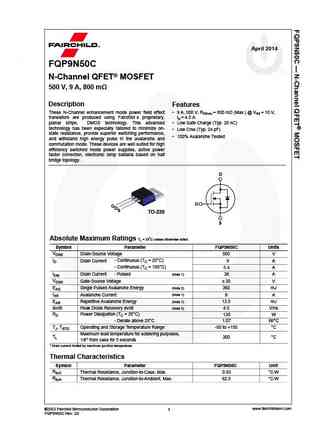
April 2014 FQP9N50C N-Channel QFET MOSFET 500 V, 9 A, 800 m Description Features These N-Channel enhancement mode power field effect 9 A, 500 V, RDS(on) = 800 m (Max.) @ VGS = 10 V, transistors are produced using Fairchild s proprietary, ID = 4.5 A planar stripe, DMOS technology. This advanced Low Gate Charge (Typ. 28 nC) technology has been especially tailored to minim
0.2. Size:845K fairchild semi
fqp9n50c fqpf9n50c.pdf 
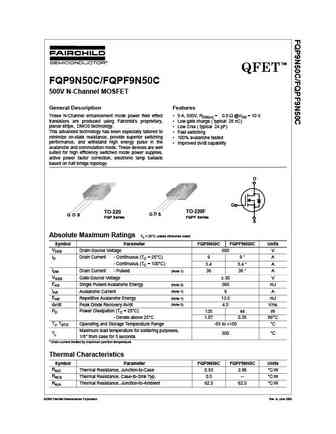
TM QFET FQP9N50C/FQPF9N50C 500V N-Channel MOSFET General Description Features These N-Channel enhancement mode power field effect 9 A, 500V, RDS(on) = 0.8 @VGS = 10 V transistors are produced using Fairchild s proprietary, Low gate charge ( typical 28 nC) planar stripe, DMOS technology. Low Crss ( typical 24 pF) This advanced technology has been especially tailored to
9.1. Size:757K fairchild semi
fqp9n15.pdf 
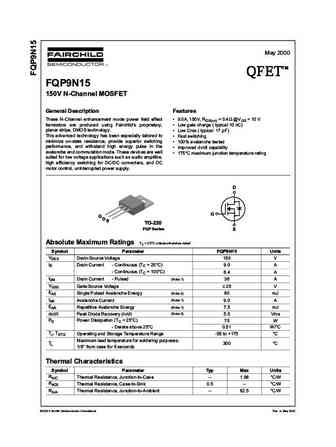
May 2000 TM QFET QFET QFET QFET 150V N-ChanneI MOSFET GeneraI Description Features These N-Channel enhancement mode power field effect 9.0A, 150V, RDS(on) = 0.4 @VGS = 10 V transistors are produced using Fairchild s proprietary, Low gate charge ( typical 10 nC) planar stripe, DMOS technology. Low Crss ( typical 17 pF) This advanced technology has been espe
9.2. Size:540K fairchild semi
fqp9n08l.pdf 

December 2000 TM QFET QFET QFET QFET FQP9N08L 80V LOGIC N-Channel MOSFET General Description Features These N-Channel enhancement mode power field effect 9.3A, 80V, RDS(on) = 0.21 @VGS = 10 V transistors are produced using Fairchild s proprietary, Low gate charge ( typical 4.7 nC) planar stripe, DMOS technology. Low Crss ( typical 16 pF) This advanced technology is
9.3. Size:1136K fairchild semi
fqp9n25c fqpf9n25c.pdf 
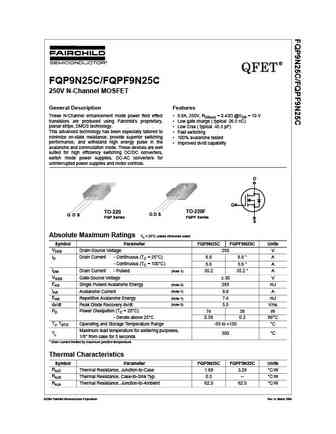
QFET FQP9N25C/FQPF9N25C 250V N-Channel MOSFET General Description Features These N-Channel enhancement mode power field effect 8.8A, 250V, RDS(on) = 0.43 @VGS = 10 V transistors are produced using Fairchild s proprietary, Low gate charge ( typical 26.5 nC) planar stripe, DMOS technology. Low Crss ( typical 45.5 pF) This advanced technology has been especially tailor
9.4. Size:1134K fairchild semi
fqp9n25c fqpf9n25ct fqpf9n25cydtu.pdf 

QFET FQP9N25C/FQPF9N25C 250V N-Channel MOSFET General Description Features These N-Channel enhancement mode power field effect 8.8A, 250V, RDS(on) = 0.43 @VGS = 10 V transistors are produced using Fairchild s proprietary, Low gate charge ( typical 26.5 nC) planar stripe, DMOS technology. Low Crss ( typical 45.5 pF) This advanced technology has been especially tailor
9.5. Size:535K fairchild semi
fqp9n08.pdf 

December 2000 TM QFET QFET QFET QFET FQP9N08 80V N-Channel MOSFET General Description Features These N-Channel enhancement mode power field effect 9.3A, 80V, RDS(on) = 0.21 @VGS = 10 V transistors are produced using Fairchild s proprietary, Low gate charge ( typical 5.9 nC) planar stripe, DMOS technology. Low Crss ( typical 13 pF) This advanced technology is especi
9.6. Size:842K fairchild semi
fqp9n90c fqpf9n90c.pdf 
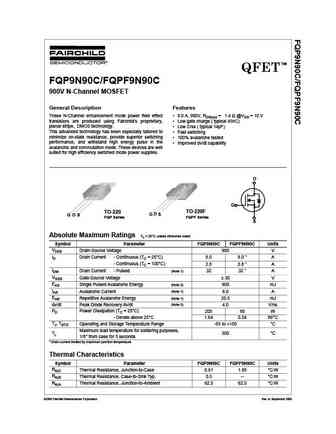
TM QFET FQP9N90C/FQPF9N90C 900V N-Channel MOSFET General Description Features These N-Channel enhancement mode power field effect 8.0 A, 900V, RDS(on) = 1.4 @VGS = 10 V transistors are produced using Fairchild s proprietary, Low gate charge ( typical 45nC) planar stripe, DMOS technology. Low Crss ( typical 14pF) This advanced technology has been especially tailored to
9.7. Size:637K fairchild semi
fqp9n30.pdf 
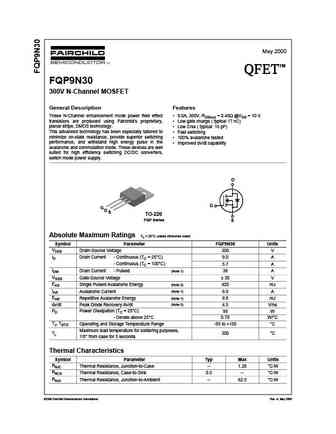
May 2000 TM QFET QFET QFET QFET FQP9N30 300V N-Channel MOSFET General Description Features These N-Channel enhancement mode power field effect 9.0A, 300V, RDS(on) = 0.45 @VGS = 10 V transistors are produced using Fairchild s proprietary, Low gate charge ( typical 17 nC) planar stripe, DMOS technology. Low Crss ( typical 16 pF) This advanced technology has been espe
9.8. Size:1136K onsemi
fqp9n25c fqpf9n25c.pdf 

QFET FQP9N25C/FQPF9N25C 250V N-Channel MOSFET General Description Features These N-Channel enhancement mode power field effect 8.8A, 250V, RDS(on) = 0.43 @VGS = 10 V transistors are produced using Fairchild s proprietary, Low gate charge ( typical 26.5 nC) planar stripe, DMOS technology. Low Crss ( typical 45.5 pF) This advanced technology has been especially tailor
9.9. Size:1200K onsemi
fqp9n90c fqpf9n90c.pdf 

Is Now Part of To learn more about ON Semiconductor, please visit our website at www.onsemi.com Please note As part of the Fairchild Semiconductor integration, some of the Fairchild orderable part numbers will need to change in order to meet ON Semiconductor s system requirements. Since the ON Semiconductor product management systems do not have the ability to manage part nomenclatur
Другие MOSFET... FQP7N65C
, FQP7N80
, FQP7P20
, FQP90N10V2
, FQP9N08
, FQP9N08L
, FQP9N15
, FQP9N25C
, IRF9540N
, FQPF10N20
, FQPF10N60CF
, FQPF10N60CT
, FQPF10N60CYDTU
, FQPF11N40CT
, FQPF11N40T
, FQPF12N60
, FQPF12N60CT
.














